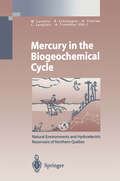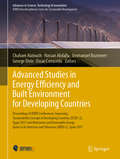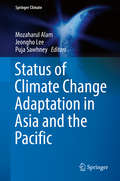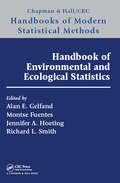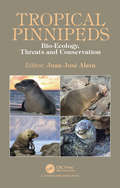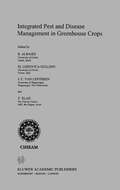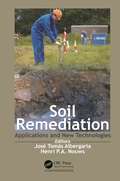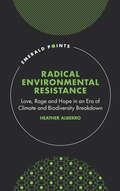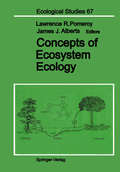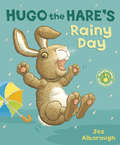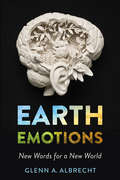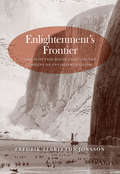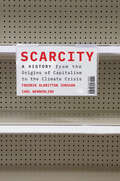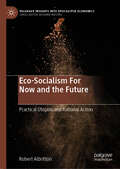- Table View
- List View
Mercury in the Biogeochemical Cycle: Natural Environments and Hydroelectric Reservoirs of Northern Québec (Canada) (Environmental Science and Engineering)
by AlainTremblay ClaudeLanglois NormandThérien RogerSchetagne MarcLucotteNowadays, major environmental issues are the object of large public debates de spite the fact that scientific knowledge is often insufficient to draw unequivocal conclusions. Such is the case in the ongoing debate regarding the specific contri butions of anthropogenic greenhouse gas emissions and of natural climate changes to global warming. At least 10 to 20 years of additional observations will be re quired, before we will be able to conclude, with certainty, on this subject. In the mean time, and as directed by their immediate interests, people will continue to promote contradictory opinions. The media are, in part, responsible for perpetuat ing such debates in that they convey indiscriminately the opinion of highly credi ble scientists as that of dogmatic researchers, the latter, unfortunately too often expressing working hypotheses as established facts. Naturally, in a similarly mis informed manner, pressure groups tend to support the researcher whose opinions most closely represent either their particular ideological battles or their economic interests and, hence, in their own way, add further to the confusion and obscurity of the debate. Only a few years ago, mercury (Hg)contamination in hydroelectric reservoirs was the object of such media and social biases. At the time, analytical data used to support the discourse were themselves uncertain and numerous hypotheses, often times fanciful, were proposed and hastily "delivered" to the public.
Advanced Studies in Energy Efficiency and Built Environment for Developing Countries: Proceedings of IEREK Conferences: Improving Sustainability Concept in Developing Countries (ISCDC-2), Egypt 2017 and Alternative and Renewable Energy Quest in Architecture and Urbanism (AREQ-2), Spain 2017 (Advances in Science, Technology & Innovation)
by Chaham Alalouch Hassan Abdalla Emmanuel Bozonnet George Elvin Oscar CarracedoThis edited volume consists of three parts. It is a culmination of selected research papers presented at the second version of the international conference on Improving Sustainability Concept in Developing Countries (ISCDC) and the second version of the international conference on Alternative and Renewable Energy Quest in Architecture and Urbanism (AREQ), organized by IEREK in Egypt, 2017. It discusses major environmental issues and challenges which threaten our future. These include climate change impact, environmental deterioration, increasing demand for energy and new approaches for alternative renewable energy sources which became a necessity for survival. In addition to addressing the different environmental issues witnessed today, research presented in this book stressed on the need of sustainably shaping buildings and cities using renewable energy sources. Topics included in this book are (1) Resilience in the Built Environment, (2) Design for energy-efficient architecture and (3) Alternative and Renewable Energy Resources Quest in Architecture and Urbanism. The book is of interest to researchers and academicians who continuously aim to update their knowledge in these fields, as well as decision makers needing the enough knowledge to carry out the right decisions towards the benefit of the environment and society.
Status of Climate Change Adaptation in Asia and the Pacific (Springer Climate)
by Mozaharul Alam Jeongho Lee Puja SawhneyThis volume provides an overview of the climate change adaptation objectives set, actions taken, and challenges faced by several countries in the Asia-Pacific region. The majority of the populations in this region struggle to make a living from subsistence agriculture, and livelihoods are highly dependent on natural ecosystem services which are likely to be severely affected by climate change. Cases discussed in this book highlight successes made by governments towards achieving adaptation objectives, and efforts required to overcome challenges. While significant economic advances have been made, the pace of growth has been slow to impact the lives of a majority of the people who live below the poverty line. The chapters highlight adaptation actions for protecting people and their livelihoods in priority sectors, maintaining food and water security, supporting socio-economic stability including poverty reduction, and climate risk management. This book also maximizes readers' insights into the knowledge gaps and limitations of stated adaptation goals, and the bottlenecks that hinder implementation in different regions.
International Natural Resources Law, Investment and Sustainability (Routledge Research in International Environmental Law)
by Shawkat Alam Jahid Hossain Bhuiyan Jona RazzaqueInternational Natural Resources Law, Investment and Sustainability provides a clear and concise insight into the relationship between the institutions that govern foreign investment, sustainable development and the rules and regulations that administer natural resources. In this book, several leading experts explore different perspectives in how investment and natural resources come together to achieve sustainable development in developing countries with examples from water, oil and gas, renewable energy, mineral, agriculture, and carbon trading. Despite varying perspectives, it is clear that several themes are central in considering the linkages between natural resources, investment and sustainability. Specifically, transparency, good governance and citizen empowerment are vital conditions which encourage positive social, economic and environmental outcomes for developing countries. In addition, this book provides new insights into key concepts which underpin international law, including sovereign rights and state responsibility principles. It is clear from this book that in the attempt to reconcile these concepts and principles from separate legal regimes, complex policy questions emerge whereby it is difficult to attain mutually beneficial or succinct outcomes. This book explores how countries prioritise their policy objectives to achieve their notion of sustainable natural resource use, which is strongly influenced by power imbalances that inform North–South cooperation, as well as South–South cooperation in the international investment regime. This book will be of great interest to students, academics and researchers of international environmental law, international human rights law, international investment law and international economic law. This book may also be of relevance to environmentalists, policy-makers, NGOs, and investors working in the natural resources field.
NGO Management: The Earthscan Companion (Earthscan Reader Ser.)
by Alan Fowler; Chiku MalungaThe task environment of NGOs is changing rapidly and significantly, making new demands on their management and leadership. This Companion discusses the complexities involved. It illustrates how NGOs can maintain performance and remain agile amidst increasing uncertainties. These factors include the position of NGOs in civil society, their involvement in governance and coping with the effects of the securitisation of international aid. Complementing The Earthscan Reader in NGO Management, selected contributions and specially commissioned pieces from NGO thought-leaders and practitioners, provide the reader with insights on the emerging thinking, competences and practices needed for success in managing and leading tomorrow's NGOs.
Handbook of Environmental and Ecological Statistics (ISSN)
by Alan Gelfand; Montse Fuentes; Jennifer A. Hoeting; Richard L. SmithThis handbook focuses on the enormous literature applying statistical methodology and modelling to environmental and ecological processes. The 21st century statistics community has become increasingly interdisciplinary, bringing a large collection of modern tools to all areas of application in environmental processes. In addition, the environmental community has substantially increased its scope of data collection including observational data, satellite-derived data, and computer model output. The resultant impact in this latter community has been substantial; no longer are simple regression and analysis of variance methods adequate. The contribution of this handbook is to assemble a state-of-the-art view of this interface. Features: An internationally regarded editorial team. A distinguished collection of contributors. A thoroughly contemporary treatment of a substantial interdisciplinary interface. Written to engage both statisticians as well as quantitative environmental researchers. 34 chapters covering methodology, ecological processes, environmental exposure, and statistical methods in climate science.
Tropical Pinnipeds: Bio-Ecology, Threats and Conservation
by Juan J. AlavaPinnipeds are a fascinating group of marine mammals that play a crucial role as apex predators and sentinels of the functioning and health of marine ecosystems. They are found in the most extreme environments from the Polar regions to the tropics. Pinnipeds are comprised of about 34 species, and of those at least 25% live permanently in tropical zones. This book reviews and updates current research on the biology, marine ecology, bio-monitoring, and conservation of tropical pinniped populations, including their behavior, anthropogenic stressors, and health. It also looks at challenges to be faced for the conservation of tropical pinnipeds, many of which are threatened species.
Tropical Pinnipeds: Bio-Ecology, Threats and Conservation
by Juan José AlavaPinnipeds are a fascinating group of marine mammals that play a crucial role as apex predators and sentinels of the functioning and health of marine ecosystems. They are found in the most extreme environments from the Polar regions to the tropics. Pinnipeds are comprised of about 34 species, and of those at least 25% live permanently in tropical zones. This book reviews and updates current research on the biology, marine ecology, bio-monitoring, and conservation of tropical pinniped populations, including their behavior, anthropogenic stressors, and health. It also looks at challenges to be faced for the conservation of tropical pinnipeds, many of which are threatened species.
Integrated Pest and Disease Management in Greenhouse Crops (Developments in Plant Pathology #14)
by Ramon Albajes Yigal Elad M. Lodovica Gullino J. C. Van LenterenThe International Centre for Advanced Mediterranean Agronomic Studies (CIHEAM), established in 1962, is an intergovernmental organization of 13 countries: Albania, Algeria, Egypt, France, Greece, Italy, Lebanon, Malta, Morocco, Portugal, Spain, Tunisia and Turkey. Four institutes (Bari, Italy; Chania, Greece; Montpellier, France; and Zaragoza, Spain) provide postgraduate education at the Master of Science level. CIHEAM promotes research networks on Mediterranean agricultural priorities, supports the organization of specialized education in member countries, holds seminars and workshops bringing together technologists and scientists involved in Mediterranean agriculture and regularly produces diverse publications including the series Options Méditerranéennes. Through these activities, CIHEAM promotes North/South dialogue and international co-operation for agricultural development in the Mediterranean region. Over the past decade, the Mediterranean Agronomic Institute of Zaragoza has developed a number of training and research-supporting activities in the field of agroecology and sustainability of agricultural production systems. Some of these activities have been concerned with the rational use of pesticides and more particularly with the implementation of integrated control systems in order to gain in efficacy and decrease both the environmental impact and the negative repercussions for the commercialization of agricultural products.
Climate Change Mitigation: Greenhouse Gas Reduction and Biochemicals
by Jimmy Alexander Faria Albanese M. Pilar RuizThis title includes a number of Open Access chapters. Climate change is a significant threat to humanity's future. Culturally, politically, economically, and personally, however, we are all deeply embedded in a system that continues to send us on a collision course that leads directly toward this threat. At this point, climate change is inevitable.
Soil Remediation: Applications and New Technologies
by Jose T. V. S. De Albergaria Hendrikus P. A. NouwsSoil contamination represents a serious environmental problem and requires an immediate action plan to be prepared for typical and emergent contaminants. This book provides an overview of some remediation technologies, both traditional and emergent, as well as case studies based on the contribution from academia and service providers. Several soil
Radical Environmental Resistance: Love, Rage and Hope in an Era of Climate and Biodiversity Breakdown (Emerald Points)
by Heather AlberroAcknowledging mounting socioeconomic inequality, a climate system in disarray, and a collapse of biodiversity that now threatens the very viability of life on earth for both present and future generations, Radical Environmental Resistance demystifies activists’ ecological worldviews, their tactical motivations, and their diagnostic and prognostic framings. Providing a succinct overview of key aspects of contemporary radical environmental movements, Heather Alberro offers a brief yet in-depth look into the poorly understood aims and motivations of radical environmental activists as increasingly salient actors within global environmental politics. Drawing on semi-structured interviews with activists from a range of environmental groups as well as analysis of activist websites and print materials, chapters feature a critical discussion of the ethics and salience of radical tactics and of attempts by state, media and corporate actors to criminalize and delegitimize environmental activism. Will mainstream policy and government approaches to addressing climate and biodiversity crises amount to too little, too late? At what point, if ever, do desperate times legitimize desperate actions? Exploring the role of direct action within times of severe social and ecological upheaval, Radical Environmental Resistance evokes the rich, diverse world that radical environmental activists and indigenous environmental protectors are fighting for.
Radical Environmental Resistance: Love, Rage and Hope in an Era of Climate and Biodiversity Breakdown (Emerald Points)
by Heather AlberroAcknowledging mounting socioeconomic inequality, a climate system in disarray, and a collapse of biodiversity that now threatens the very viability of life on earth for both present and future generations, Radical Environmental Resistance demystifies activists’ ecological worldviews, their tactical motivations, and their diagnostic and prognostic framings. Providing a succinct overview of key aspects of contemporary radical environmental movements, Heather Alberro offers a brief yet in-depth look into the poorly understood aims and motivations of radical environmental activists as increasingly salient actors within global environmental politics. Drawing on semi-structured interviews with activists from a range of environmental groups as well as analysis of activist websites and print materials, chapters feature a critical discussion of the ethics and salience of radical tactics and of attempts by state, media and corporate actors to criminalize and delegitimize environmental activism. Will mainstream policy and government approaches to addressing climate and biodiversity crises amount to too little, too late? At what point, if ever, do desperate times legitimize desperate actions? Exploring the role of direct action within times of severe social and ecological upheaval, Radical Environmental Resistance evokes the rich, diverse world that radical environmental activists and indigenous environmental protectors are fighting for.
Responsibility and Liability in the Context of Transboundary Movements of Hazardous Wastes by Sea: Existing Rules and the 1999 Liability Protocol to the Basel Convention (Hamburg Studies on Maritime Affairs #29)
by Jan AlbersThe term “hazardous wastes” covers a wide range of disused products and production wastes generated not only in industrial sectors, but also in all areas of everyday life. Hazardous wastes are to a large extent shipped by sea to third countries for recycling or disposal. While the procedural requirements for such movements are laid out in the 1989 Basel Convention, explicit rules of responsibility and liability for resulting damages are neither provided by the Basel Convention nor by other international conventions. The Liability Protocol to the Basel Convention of 1999 has not yet entered into force. This book examines the existing rules of responsibility and liability applying to States and private persons and outlines the conditions under which liability may be incurred. Subsequently, the advantages and shortcomings of the 1999 Liability Protocol are analyzed. Although this Protocol faces substantial political headwind, from a legal perspective it includes principally useful and reasonable approaches and should therefore be ratified.
Svalbard Imaginaries: The Making of an Arctic Archipelago (Arctic Encounters)
by Mathias Albert Dina Brode-Roger Lisbeth IversenBy drawing on a broad range of disciplinary backgrounds, this book illustrates the immense complexities of Svalbard as a place, point of reference, or social concept. It portrays the multiple, situated perspectives that characterize understandings and imaginings of Svalbard, and brings together contributions from academic fields that rarely interact with each other.Svalbard Imaginaries contributes to a number of research contexts, ranging from a broadly conceived, multi-disciplinary field of ‘Arctic Studies’ to more disciplinary specific debates on how places are reworked at the interstices of various global flows and vice versa. It assembles contributions on imaginaries that cover a wide array of issues, including—but not limited to—Svalbard as a geopolitical site, a landscape, an image, a (mining) heritage assemblage, a tourist destination, a wilderness, a built environment, a site of knowledge production, a site of artistic engagement, and projections of the future. It deliberately assembles analyses that refer to a variety of timescales and covers representations of the past, the present, and possible futures of Svalbard.
Performance Metrics for Sustainable Cities (Advances in Urban Sustainability)
by Sylvie Albert Manish PandeyPerformance Metrics for Sustainable Cities provides an overview of measurement systems and tools to enable communities to self-assess and benchmark their progress along a continuum of smart, intelligent, and sustainable development. It begins by explaining the importance of measurement and evaluation for cities and smaller communities, as well as future factors that will need to be considered and embedded into planning processes. Across 14 chapters, the book describes existing evaluation mechanisms that are being used for government funding decisions, awards of recognition, and new measurement systems to assess what makes a city smarter and more sustainable, such as broader sustainable goal targets (UN SDGs), green cities, fabrication cities, and compassionate cities. It presents examples of metrics used for important sustainability and liveability concepts for cities such as how to measure trust, engagement, compassion, circular economy, and so forth. The book ends with reflections on the feasibility of a holistic system of measurement and the implications of its implementation. This volume will be of great interest to students, researchers, and professionals of urban sustainability, planning, smart cities, and sustainable communities.
Concepts of Ecosystem Ecology: A Comparative View (Ecological Studies #67)
by J. J. Alberts R. T. Barber D. C. Coleman K. W. Cummins C. F. D'Elia J. K. Detling E. C. Hargrove P. F. Hendrix K. H. Mann S. L. Pimm L. R. Pomeroy W. A. Reiners P. H. Rich P. G. Risser J. E. Schindler H. H. Shugart D. L. Urban W. J. Wiebe R. G. WiegertIn this volume 19 leading experts offer a timely and coherent overview of the fundamental principles of ecosystem science. They examine the flux of energy and biologically essential elements and their associated food webs in major terrestrial and aquatic ecosystems, such as forests, grasslands, cultivated land, streams, coral reefs, and ocean basins. In each case, interactions between different eosystems, predictive models, and the application of ecosystem research to the management of natural resources are given special emphasis. A number of theoretical chapters provide a synthesis through critical discussion of current concepts of ecosystem energetics and dynamics.
The Stranger in the Lifeboat
by Mitch AlbomThe stunning new novel from the bestselling author of global phenomenon Tuesdays with MorrieAdrift in a raft after a terrible shipwreck, ten strangers try to survive while they wait for rescue.After three days, short on water, food and hope, they spot a man floating in the waves.They pull him on board - and the survivor claims he can save them.But should they put their trust in him?Will any of them see home again?And why did the ship really sink?The Stranger in the Lifeboat is not only a deeply moving novel about the power of love and hope in the face of danger, but also a mystery that will keep you guessing to the very end.'Mitch Albom sees the magical in the ordinary' Cecelia Ahern'He has the ability to make you cry in spite of yourself' Boston Globe'Albom has touched the lives of a lot of people he never even knew' Time
Hugo the Hare's Rainy Day (Nat the Cat)
by Jez AlboroughHugo the Hare HATES to get wet, and when the rain comes he huddles under his umbrella. But Hugo's friends are stuck in the rain and when Hugo comes to their rescue he can't help but get all soggy!However, perhaps having a bit of a splish splash isn't quite as bad as Hugo thinks...
Implementing Adaptation Strategies by Legal, Economic and Planning Instruments on Climate Change (Environmental Protection in the European Union #4)
by Eike Albrecht Michael Schmidt Magdalena Mißler-Behr Simon P. N. SpyraThe causes and effects of climate change are just as varied as the proposed solutions and approaches for dealing with the problem. Given the global character of climate change, comprehensive global cooperation is called for that leads to effective and appropriate international action in accordance with the respective responsibilities. These will inevitably differ depending on the capabilities and the social and economic situations of the respective actors.The contributions in this book present a variety of ideas, approaches and tools regarding the adaptation to climate change in specific countries and regions. In addition to examining (existing) legal instruments, they also focus on the implementation of economic instruments and planning tools, as well as their (further) development. Rather than simply discussing strategies to counteract climate change by reducing emissions, the authors also search for ways of actively adapting to climate change.
Earth Emotions: New Words for a New World
by Glenn A. AlbrechtAs climate change and development pressures overwhelm the environment, our emotional relationships with Earth are also in crisis. Pessimism and distress are overwhelming people the world over. In this maelstrom of emotion, solastalgia, the homesickness you have when you are still at home, has become, writes Glenn A. Albrecht, one of the defining emotions of the twenty-first century.Earth Emotions examines our positive and negative Earth emotions. It explains the author's concept of solastalgia and other well-known eco-emotions such as biophilia and topophilia. Albrecht introduces us to the many new words needed to describe the full range of our emotional responses to the emergent state of the world. We need this creation of a hopeful vocabulary of positive emotions, argues Albrecht, so that we can extract ourselves out of environmental desolation and reignite our millennia-old biophilia—love of life—for our home planet. To do so, he proposes a dramatic change from the current human-dominated Anthropocene era to one that will be founded, materially, ethically, politically, and spiritually on the revolution in thinking being delivered by contemporary symbiotic science. Albrecht names this period the Symbiocene.With the current and coming generations, "Generation Symbiocene," Albrecht sees reason for optimism. The battle between the forces of destruction and the forces of creation will be won by Generation Symbiocene, and Earth Emotions presents an ethical and emotional odyssey for that victory.
Enlightenment's Frontier: The Scottish Highlands and the Origins of Environmentalism (The Lewis Walpole Series in Eighteenth-Century Culture and History)
by Dr. Fredrik Albritton JonssonEnlightenment’s Frontier is the first book to investigate the environmental roots of the Scottish Enlightenment. What was the place of the natural world in Adam Smith’s famous defense of free trade? Fredrik Albritton Jonsson recovers the forgotten networks of improvers and natural historians that sought to transform the soil, plants, and climate of Scotland in the eighteenth century. The Highlands offered a vast outdoor laboratory for rival liberal and conservative views of nature and society. But when the improvement schemes foundered toward the end of the century, northern Scotland instead became a crucible for anxieties about overpopulation, resource exhaustion, and the physical limits to economic growth. In this way, the rise and fall of the Enlightenment in the Highlands sheds new light on the origins of environmentalism.
Scarcity: A History from the Origins of Capitalism to the Climate Crisis
by Fredrik Albritton Jonsson Carl WennerlindA sweeping intellectual history of the concept of economic scarcity—its development across five hundred years of European thought and its decisive role in fostering the climate crisis.Modern economics presumes a particular view of scarcity, in which human beings are innately possessed of infinite desires and society must therefore facilitate endless growth and consumption irrespective of nature’s limits. Yet as Fredrik Albritton Jonsson and Carl Wennerlind show, this vision of scarcity is historically novel and was not inevitable even in the age of capitalism. Rather, it reflects the costly triumph of infinite-growth ideologies across centuries of European economic thought—at the expense of traditions that sought to live within nature’s constraints.The dominant conception of scarcity today holds that, rather than master our desires, humans must master nature to meet those desires. Albritton Jonsson and Wennerlind argue that this idea was developed by thinkers such as Francis Bacon, Samuel Hartlib, Alfred Marshall, and Paul Samuelson, who laid the groundwork for today’s hegemonic politics of growth. Yet proponents of infinite growth have long faced resistance from agrarian radicals, romantic poets, revolutionary socialists, ecofeminists, and others. These critics—including the likes of Gerrard Winstanley, Dorothy Wordsworth, Karl Marx, and Hannah Arendt—embraced conceptions of scarcity in which our desires, rather than nature, must be mastered to achieve the social good. In so doing, they dramatically reenvisioned how humans might interact with both nature and the economy.Following these conflicts into the twenty-first century, Albritton Jonsson and Wennerlind insist that we need new, sustainable models of economic thinking to address the climate crisis. Scarcity is not only a critique of infinite growth, but also a timely invitation to imagine alternative ways of flourishing on Earth.
Eco-Socialism For Now and the Future: Practical Utopias and Rational Action (Palgrave Insights into Apocalypse Economics)
by Robert AlbrittonIt is increasingly apparent that capitalism cannot stave off the truly frightening ecological disasters that threaten the future of life on earth. Is it an accident that the strongest and most capitalist economic force in the world, the US, is also that force that is most prone to the denial of the enormous dangers of global warming? While capitalism is a global force, it is not supported by the majority of the world, and much more thought and action is needed to integrate and globalize movements against oppression, injustice and ecological destruction. While changes at a local level are important and more feasible in our current world, ultimately changes at a global level may have greater long-term importance, and we need to greatly expand theorizations and mobilizations in this direction now. Robert Albritton proposes 'practical utopias' as a process of thinking by which short-term changes tend in the direction of desirable changes in the long term.
Life in Europe Under Climate Change
by Joseph Alcamo Jorgen E. OlesenLife in Europe will indeed go on as the climate changes, but not in the same way as before. The air will be warmer, winds will change, patterns of rainfall and snowfall will alter, and sea level is likely to rise. These phenomena are already being seen. Europe will in the future experience marked changes in vegetation cover, increased floods along rivers and coastlines as well as more frequent droughts and forest fires, often leading to large societal costs. The changes will be minor in some cases, profound in others, but in any case, pervasive. This book uses the most up to date information issued by the IPCC (Intergovernmental Panel on Climate Change), and informs readers about these effects, as well as showing how Europe is contributing to attempts to slow the tempo of global climate change, and how it can adapt to the climate change that seems unavoidable. Life in Europe under Climate Change makes essential information on climate impacts in Europe accessible to a broad audience, including students, politicians, planners and members of non-governmental organizations.
